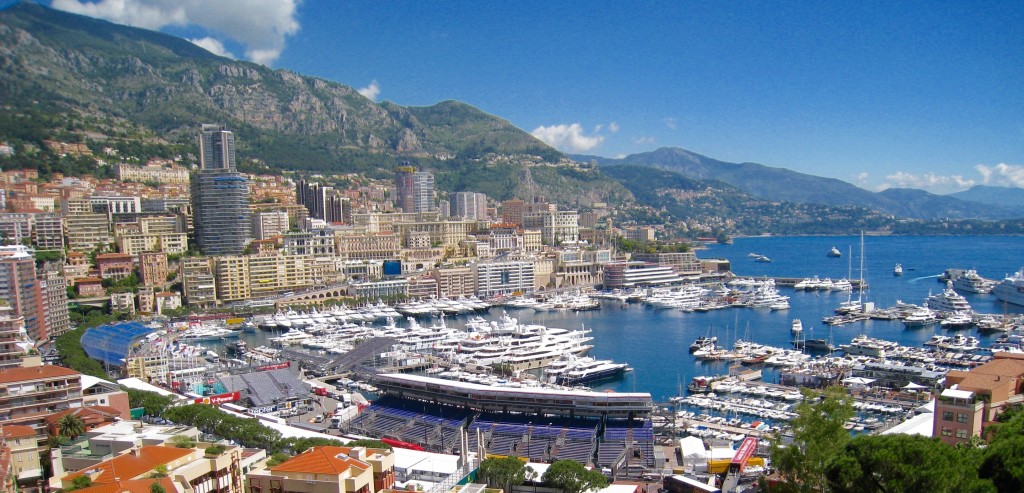 Monday morning the sun appeared as we jumped on the A8 and motored toward the Nice airport. There, we would drop off the rental car and catch a ride to our hotel in Monte Carlo. As we exited the subterranean parking lot in Avignon, we misjudged the distance from the car to the wall of the underground garage. I winced as we made the tight, sharp angle, not surprised to hear the grind of metal against stone, and wondered how much repairs would cost. But a little over two hours later, when we turned in the car, the Avis representative seemed nonplussed as he looked at the damage. “That’s nothing. Happens a lot,” he said and told us to have a safe trip down to Monaco. read more…
Monday morning the sun appeared as we jumped on the A8 and motored toward the Nice airport. There, we would drop off the rental car and catch a ride to our hotel in Monte Carlo. As we exited the subterranean parking lot in Avignon, we misjudged the distance from the car to the wall of the underground garage. I winced as we made the tight, sharp angle, not surprised to hear the grind of metal against stone, and wondered how much repairs would cost. But a little over two hours later, when we turned in the car, the Avis representative seemed nonplussed as he looked at the damage. “That’s nothing. Happens a lot,” he said and told us to have a safe trip down to Monaco. read more…
Hardwired
Texas Author Pat Krapf
Europe 2013: Day Two in Beaune
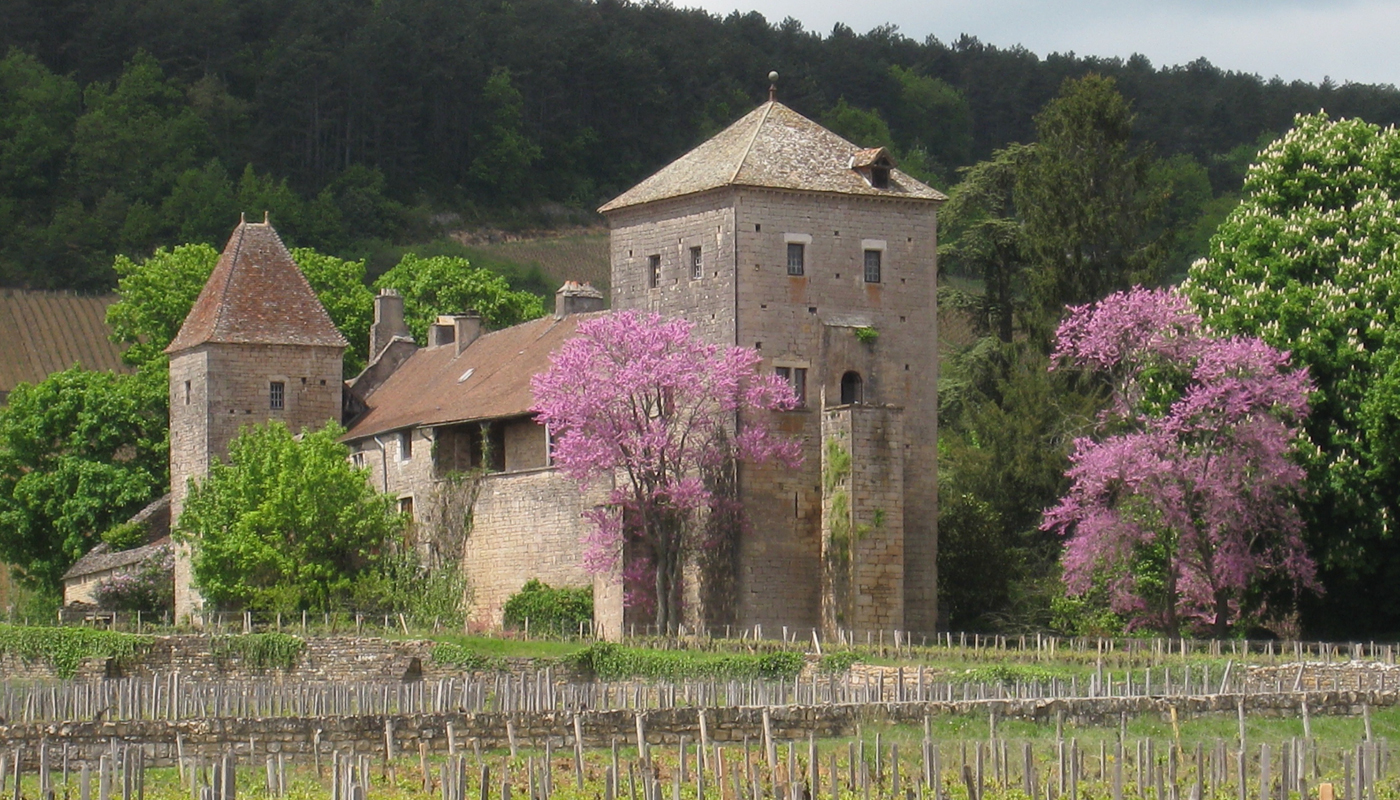
Day two in Beaune. I tucked a rain jacket and umbrella into my backpack and was ready to face the elements for our all-day excursion into the Burgundy wine region. We had hired a local guide for a private tour of some wineries, as well as to provide a deeper understanding of the oenology and the geology of the Burgundy region. Having lived in California for decades, we were both familiar with our local wine regions, so we weren’t new to viticulture or winemaking in general, and while Dave was well-versed on French wine production, I was not. And, I soon discovered, unlike at most wineries in California, you can’t simply stop in for a tasting and a purchase at any French winery you choose to visit.
Our guide met us at our hotel, and we sped away to downtown Beaune, just minutes away. As we walked through the narrow streets of this charming town, she gave us a brief history of Beaune and pointed out significant landmarks along the way. One sight that caught my attention was a model of the Beaune ramparts, which we planned to explore the next day.
We arrived at our guide’s office and settled in for an in-depth discussion on viticulture and vinification, and she was certainly a wealth of knowledge on both subjects. During the hour-long talk we tasted wines from various villages in the Côte de Beaune, which gave us a better grasp of just how important the terroir is to wine growing and how it affects a wine’s taste. The terroir is the symbiosis of grape, soil, climate, vineyard placement, and the human touch, all rolled into one.
“Now we will go on the ground,” said our guide. As an avid gardener, I hoped this meant what I thought it did, and I was right. We drove through the countryside, stopping at intervals to feel the soil in which the grapes grew, learning hands-on about viticulture and how geology impacts wine growing. A side note: 95 percent of all wine produced in the Burgundy region, from Dijon to Lyon, comes from two specific grape varieties: pinot noir and chardonnay.
From the Côte de Beaune region in the southern half of Burgundy, we retraced our route north to the Côte de Nuits. Ninety-five percent of the wine produced in this district is red, predominantly from the pinot noir grape. The most famous and most expensive come from the grand cru vineyards of Vosne-Romanée and Chambolle-Musigny. The remaining 5 percent is white, but the white wine mecca of Burgundy is really the Côte de Beaune region.
 Our first stop in the Côte de Nuits was the Clos de Vougeot, a wall-enclosed vineyard (clos) with a 125 acres under vine. It is the largest single vineyard in the Côte de Nuits that’s entitled to the grand cru designation; a wine of the most superior grade. The vineyard, like so many in the region, was created by the Cistercian monks. The land was either purchased or donated. In 1336 a wall was built around the vineyard, and in 1551 a château was added. During the French Revolution, all vineyard possessions were confiscated and sold to private buyers. In 1818 the château and vineyards were purchased by Julien-Jules Ouvrard and remained a monopole until his death. A monopole (monopoly in French) is an area controlled by a single winery and can be as small as a vineyard or as large as an entire appellation. An appellation is a legally defined and protected geographical indication used to identify where the grapes for a wine were grown. Also note that, unlike in most of the world’s vineyards, single ownership is rare in Burgundy.
Our first stop in the Côte de Nuits was the Clos de Vougeot, a wall-enclosed vineyard (clos) with a 125 acres under vine. It is the largest single vineyard in the Côte de Nuits that’s entitled to the grand cru designation; a wine of the most superior grade. The vineyard, like so many in the region, was created by the Cistercian monks. The land was either purchased or donated. In 1336 a wall was built around the vineyard, and in 1551 a château was added. During the French Revolution, all vineyard possessions were confiscated and sold to private buyers. In 1818 the château and vineyards were purchased by Julien-Jules Ouvrard and remained a monopole until his death. A monopole (monopoly in French) is an area controlled by a single winery and can be as small as a vineyard or as large as an entire appellation. An appellation is a legally defined and protected geographical indication used to identify where the grapes for a wine were grown. Also note that, unlike in most of the world’s vineyards, single ownership is rare in Burgundy.
After Ouvrard’s death, Clos de Vougeot passed to three heirs but continued to be operated as a single property until 1889, when the heirs sold and the vineyard was bought by six Burgundy wine merchants. This was the first time the land had been subdivided since the creation of the vineyard some seven hundred years earlier. Over the years, the holdings have been progressively subdivided by inheritance or sales, and as of the early 2000s Clos de Vougeot is now split among eighty-six owners. These producers either make cuvées under their own brands, sell their grapes to vintners, or both. And with its array of owners, Clos de Vougeot is arguably one of the most diverse sources of pinot noir in the world.
Next, our guide explained how much the soils can vary even within this 125-acre tract. The soils around the château are chalky and gravelly oolitic limestone and therefore have good drainage. Those in the middle part of the vineyard are soft limestone with clay and some gravel, resulting in moderate drainage. The bottom part of the vineyard is humus-rich alluvial clay and is flat, making for poor drainage.
What about appellation laws and regulations for the French wine industry? I won’t even attempt to go into this, only to say the industry is heavily regulated, and some of your best fine wines are produced here, allowing you to cellar them for years.
Later, when I commented on the size of Clos de Vougeot—large for the region—our guide said most grand cru sites are closer to thirty-five acres, with the average being eleven acres, so the clos is indeed a large grand cru vineyard. And after I checked prices for some of the wines produced in this region, approximately $200 to $3800 per bottle, I can see why Burgundy isn’t popping corks to draw tourists to daily wine tastings. You can, however, plan in advance and make an appointment to tour a specific winery, such as Maison Louis Latour or Louis Jadot.
As I walked through the grounds of the Château du Clos de Vougeot, I was amazed by the tall, sweeping roofs that almost touch the ground, and I marveled at the giant wine presses built by the Cîteaux monks.
My head was still buzzing with wine facts as we approached our last stop of the day—Gevrey-Chambertin, the largest wine-producing village in Burgundy’s Côte d’Or district. While our guide answered the few remaining questions Dave had on viticulture, I took in the scenery and soaked up some rays. The sun had finally appeared to warm the day.
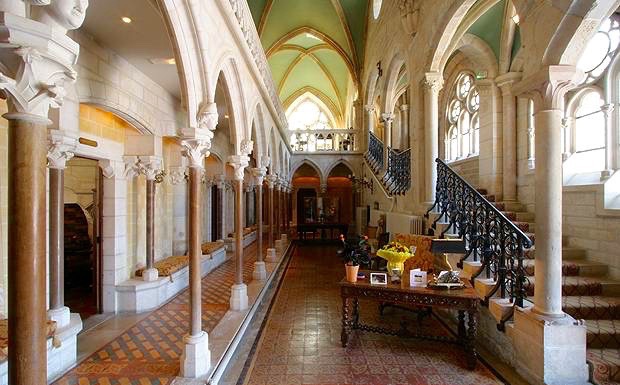 Late in the afternoon our guide dropped us at our hotel, and we immediately prepared for our drive from Beaune back to Dijon, about a fifty-minute trip, as we had dinner reservations at Abbaye de la Bussière. As we wound our way through the Ouche valley, the countryside picturesque and unspoiled, we were glad we had our GPS to guide us. We turned onto one, then another country crossroad and kept going until I was certain we were hopelessly lost, but we soon spotted the Burgundy Canal and knew we were on course. We followed the river, and before long there appeared before us a grand gateway. The drive curved past willow trees and a duck pond, and Shetland ponies grazed on the grass. We parked and were escorted into a main hall.
Late in the afternoon our guide dropped us at our hotel, and we immediately prepared for our drive from Beaune back to Dijon, about a fifty-minute trip, as we had dinner reservations at Abbaye de la Bussière. As we wound our way through the Ouche valley, the countryside picturesque and unspoiled, we were glad we had our GPS to guide us. We turned onto one, then another country crossroad and kept going until I was certain we were hopelessly lost, but we soon spotted the Burgundy Canal and knew we were on course. We followed the river, and before long there appeared before us a grand gateway. The drive curved past willow trees and a duck pond, and Shetland ponies grazed on the grass. We parked and were escorted into a main hall.
 Abbaye de la Bussière is a Cistercian monastery built in 1131 by Stephen Harding, an Englishman, of the Cistercian Order at Cîteaux. Following the French Revolution, the monks were expelled and the property sold at auction. It remained in private hands until it was returned to the Catholic church in 1921 to serve as a spiritual retreat. In decline and decay, the church decided to sell the abbey in 2005. Today it is owned by the Cummings family and is an exclusive boutique hotel set on fifteen acres of parkland with a lake and a botanical garden. The abbey is surrounded by historic vineyards, Gevrey-Chambertin being one of them. There are sixteen guest rooms, all lavishly decorated, and fine dining is in the main abbey building, a cathedral-like setting with honey-colored stonework, traceries, ornate staircases, and stained glass windows that cast soft turquoise light on the vaulted ceilings and walls.
Abbaye de la Bussière is a Cistercian monastery built in 1131 by Stephen Harding, an Englishman, of the Cistercian Order at Cîteaux. Following the French Revolution, the monks were expelled and the property sold at auction. It remained in private hands until it was returned to the Catholic church in 1921 to serve as a spiritual retreat. In decline and decay, the church decided to sell the abbey in 2005. Today it is owned by the Cummings family and is an exclusive boutique hotel set on fifteen acres of parkland with a lake and a botanical garden. The abbey is surrounded by historic vineyards, Gevrey-Chambertin being one of them. There are sixteen guest rooms, all lavishly decorated, and fine dining is in the main abbey building, a cathedral-like setting with honey-colored stonework, traceries, ornate staircases, and stained glass windows that cast soft turquoise light on the vaulted ceilings and walls.
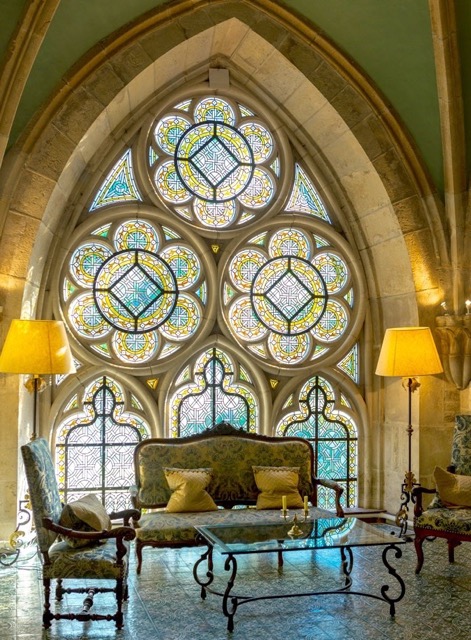 The abbey’s main restaurant is in the former refectory. Seated at a table tucked into a corner, we settled in for a most memorable meal. For starters I ordered the escargot, served with a garlic-suffused green risotto topped with goat cheese foam. It came in a tapered parfait glass, the green risotto at the bottom topped with the goat cheese foam, and in the center of the topping the escargot. The presentation was as delicious to view as the dish was to eat. Dave ordered the crayfish and smoked eel with a candied quail egg on marmalade tomato and anchovy cream. For the main course, I had trout served with basmati rice, capers, golden raisins, and herbs. The whole grilled trout was expertly filleted at our table. Dave ordered free-range pork, morels, and roasted potatoes, with a light emulsion of green pepper and rosemary. For dessert, we selected our favorite cheeses from the cheese trolley and sipped an excellent French port.
The abbey’s main restaurant is in the former refectory. Seated at a table tucked into a corner, we settled in for a most memorable meal. For starters I ordered the escargot, served with a garlic-suffused green risotto topped with goat cheese foam. It came in a tapered parfait glass, the green risotto at the bottom topped with the goat cheese foam, and in the center of the topping the escargot. The presentation was as delicious to view as the dish was to eat. Dave ordered the crayfish and smoked eel with a candied quail egg on marmalade tomato and anchovy cream. For the main course, I had trout served with basmati rice, capers, golden raisins, and herbs. The whole grilled trout was expertly filleted at our table. Dave ordered free-range pork, morels, and roasted potatoes, with a light emulsion of green pepper and rosemary. For dessert, we selected our favorite cheeses from the cheese trolley and sipped an excellent French port.
As we drove away from the abbey, I wondered what the Cistercian monks would have thought of the monastery today, knowing no vestiges of their strict monastic orders of self-denial, seclusion, and silence remain today. But it was a fleeting thought, as it was obvious that the Cummings have gone to great effort to successfully restore the abbey to it glorious medieval self and are carrying on the Cistercians’ passion for surrounding themselves with peace and natural beauty, which kept the monks close to the earth of which God had made them stewards.
Europe 2013: The Louvre
Monday morning dawned cool and gray, but the weather wouldn’t affect our plans for the morning, because we had reserved a tour of the Louvre. However, we hoped the skies would clear by early evening as we had dinner reservations at Jules Verne in the Eiffel Tower and were looking forward to a panoramic view of Paris.
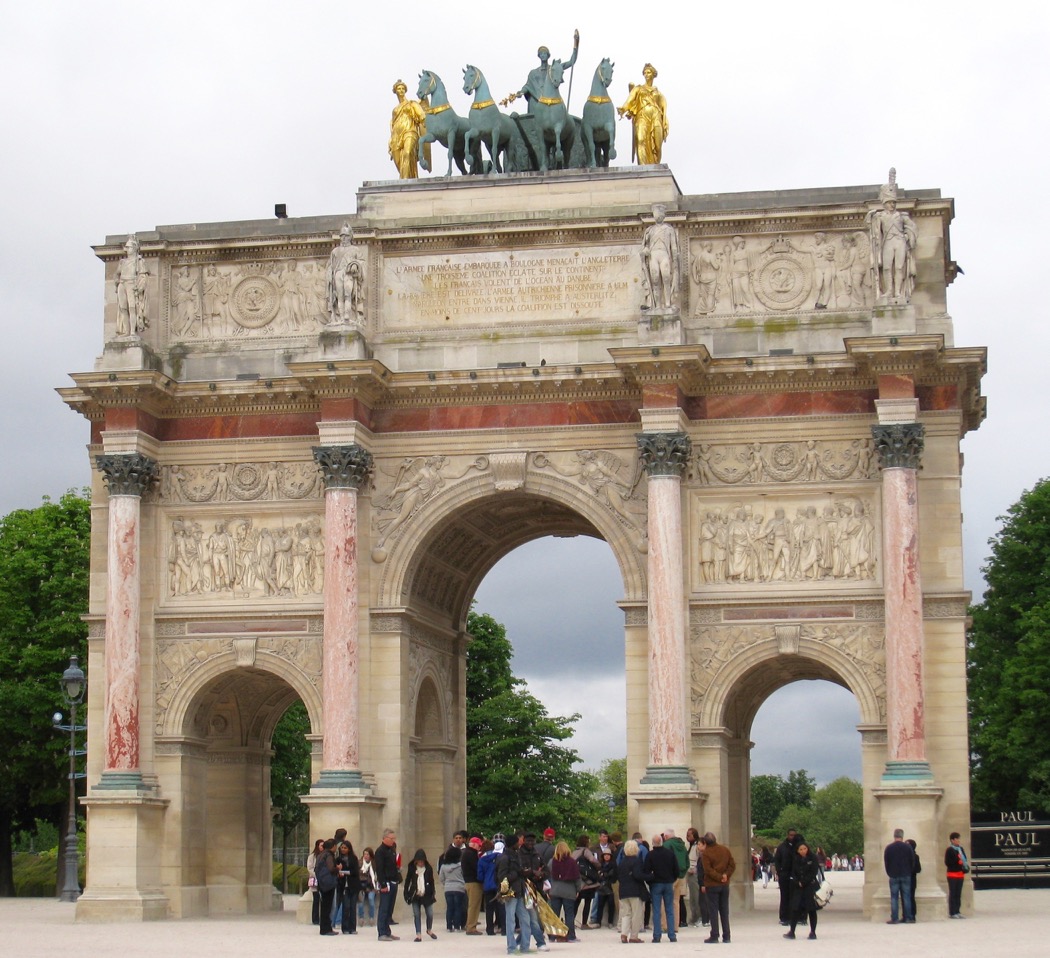 Breakfast at the Hôtel Duminy-Vendôme was on the bottom floor in a former cellar. Wine cellar, perhaps? Unlikely, since I had read the building was once a bank, and it had one of the smallest elevators I have ever been in. Our server led us to a quiet corner in the delightfully decorated room with a vaulted roof. I took in the soothing black-and-white decor while Dave perused the breakfast buffet. Mindful of the time, we ate, then left to meet our guide at the Arc de Triomphe du Carrousel.
Breakfast at the Hôtel Duminy-Vendôme was on the bottom floor in a former cellar. Wine cellar, perhaps? Unlikely, since I had read the building was once a bank, and it had one of the smallest elevators I have ever been in. Our server led us to a quiet corner in the delightfully decorated room with a vaulted roof. I took in the soothing black-and-white decor while Dave perused the breakfast buffet. Mindful of the time, we ate, then left to meet our guide at the Arc de Triomphe du Carrousel.
As we had done in Versailles, we opted to “skip the line” in favor of a guided tour of the museum, a good decision considering the size of the Louvre and all it has to offer. Our feisty French guide was organized, personable, and knowledgeable in both art and history, so she had no trouble keeping her small group entertained and engaged for the hour-and-a-half tour. I had my list of must-sees, even though I was still suffering from a slight case of visual overload after our visit the day before to the Château de Versailles.
 Approaching the museum, I immediately zeroed in on I.M. Pei’s Pyramid, a seventy-one-foot-tall, interlinked steel structure sheathed in reflective, tempered glass—a masterpiece of design. Once inside, I, of course, had to photograph Pei’s self-supporting helical staircase that curls around and down from street level to the subterranean courtyard. The stair treads are of white stone with polished metal supports and the balustrade of clear glass and stainless steel. The staircase curves around an elevator that disappears completely once it has descended. Reluctantly, I left the staircase, sorry I didn’t have the chance to see the elevator in operation, and caught up to the tour. But I’ve since watched it in operation on YouTube.
Approaching the museum, I immediately zeroed in on I.M. Pei’s Pyramid, a seventy-one-foot-tall, interlinked steel structure sheathed in reflective, tempered glass—a masterpiece of design. Once inside, I, of course, had to photograph Pei’s self-supporting helical staircase that curls around and down from street level to the subterranean courtyard. The stair treads are of white stone with polished metal supports and the balustrade of clear glass and stainless steel. The staircase curves around an elevator that disappears completely once it has descended. Reluctantly, I left the staircase, sorry I didn’t have the chance to see the elevator in operation, and caught up to the tour. But I’ve since watched it in operation on YouTube.
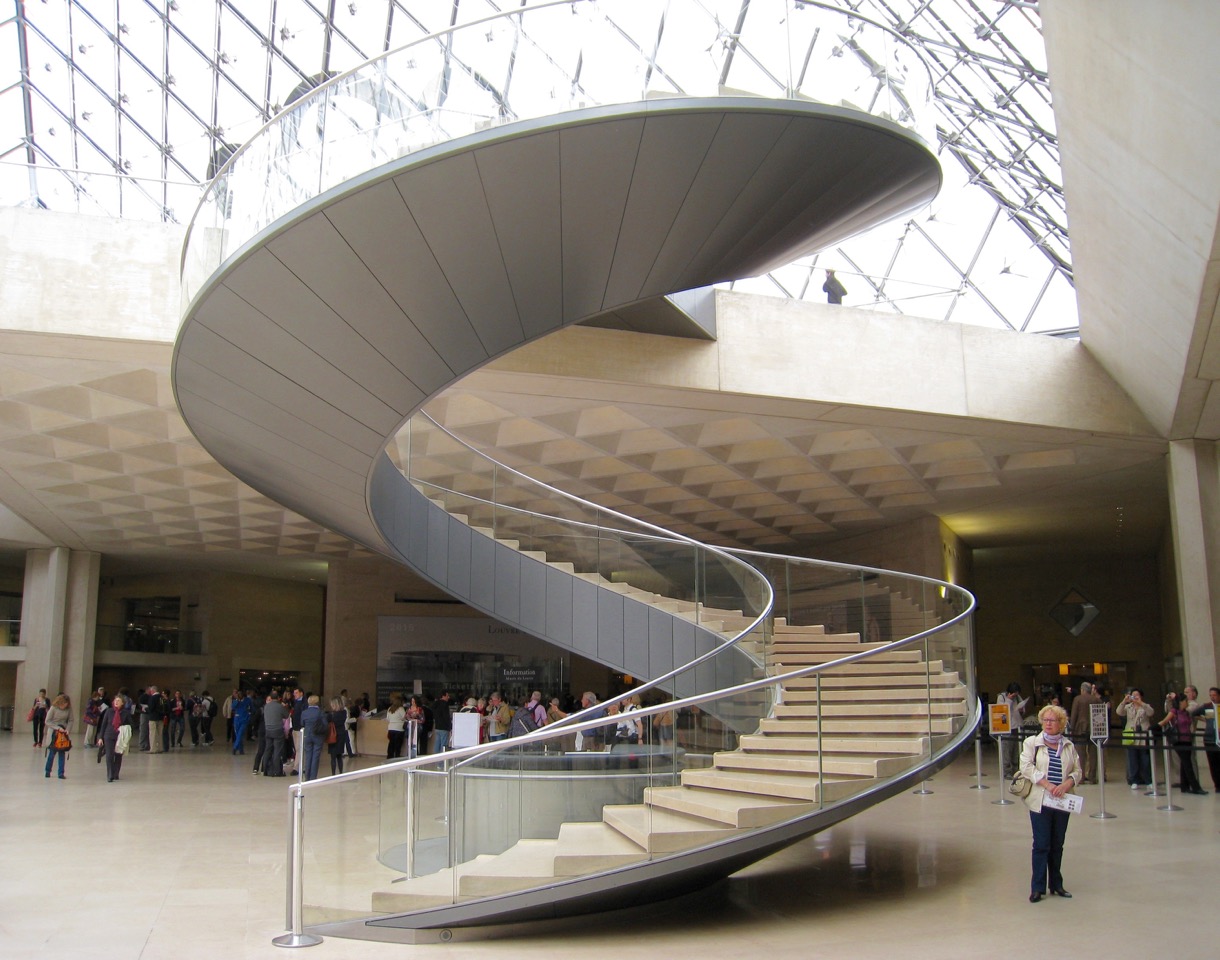
We began our tour on the lower ground floor. Many people aren’t aware that beneath the world’s most-visited museum lies the ruins of a once magnificent medieval fortress constructed in 1190 AD. During the forty-three-year reign of Philippe Auguste (1180–1223), a rampart was built around Paris, then Europe’s biggest city. To protect the capital from the Anglo-Norman threat, the king reinforced his defenses with a fortress built on the banks of the Seine. The fortification became known as the Louvre. The castle was a fortress but not a royal palace, our guide was quick to point out. At the time, the monarch’s Parisian home was the Palais de la Cité. The fortress Philippe had built was an arsenal with a moat, bastions, and defensive towers. In the center stood the massive cylindrical keep, the Grosse Tour, a fortified tower within the fortress walls, usually the last place of refuge when defending the castle. In 1527 the medieval keep was demolished to make way for a Renaissance palace. Fascinated by this bit of history, I hung back to examine more closely the ruins of the moat and the model of the original castle, which was on display.
On the ground floor, I took my time viewing the Arts of Africa exhibition, my interest springing from the years I had lived on the continent. And I spent quite some time photographing and enjoying Michelangelo’s Captive.
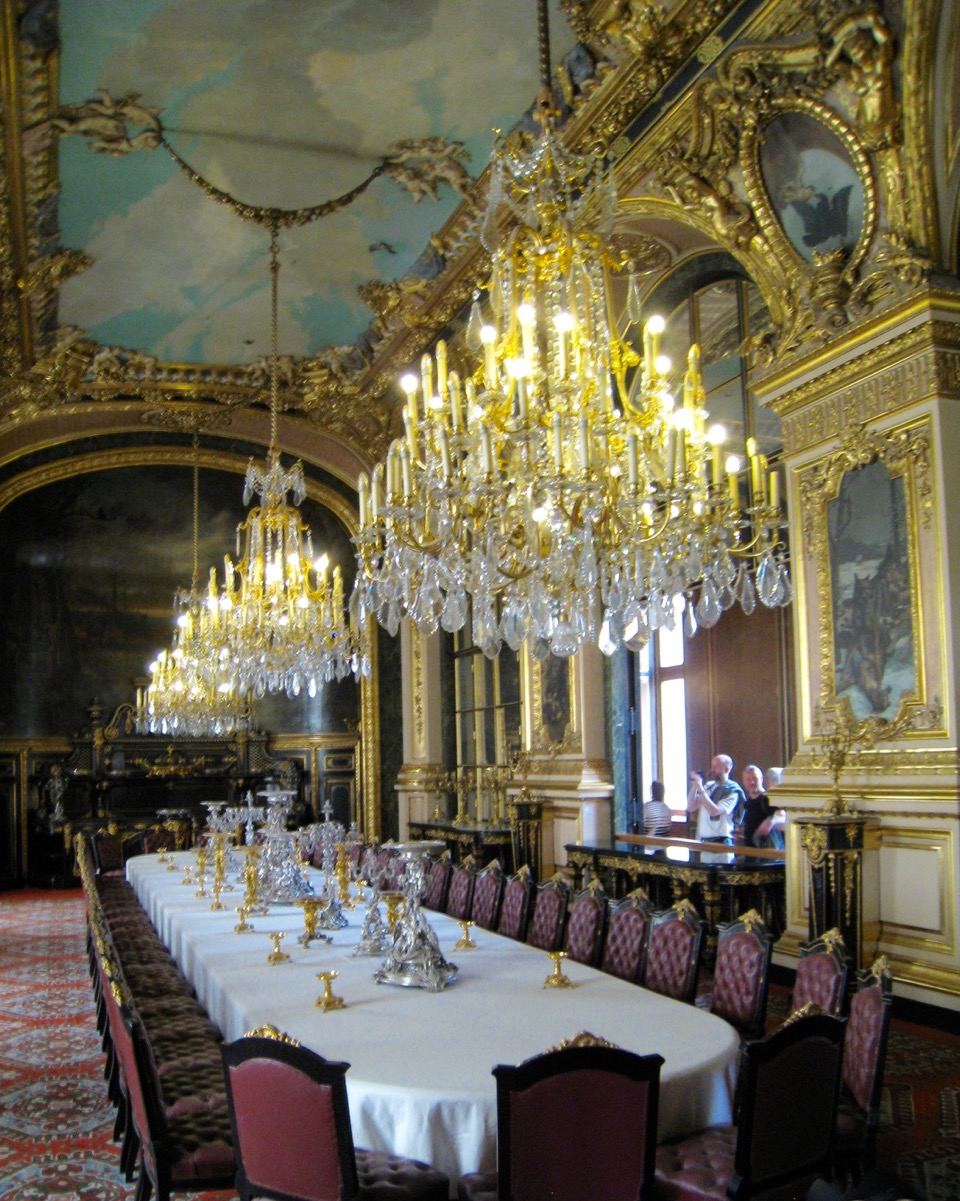
On the first floor, while Dave was absorbed in checking out The Winged Victory of Samothrace, I was busy photographing the Napoleon III Apartments. He approached to tell me our guide was giving a brief history of the Mona Lisa. I broke from snapping photos of Napoleon’s opulent furnishings for my first glimpse of Leonardo da Vinci’s masterpiece. I had to wait for the hordes of tourists to clear from my viewfinder before I could take a picture.
On the second floor, Dave strolled from one painting to the next. My attention, however, was fixed on one, Self-Portrait by Albrecht Dürer, created at the age of twenty-two. Dürer was born in Nuremberg, but his parents were Hungarian. Not only was he a painter, but also an engraver, and his attention to small details was what drew me to his work. During his lifetime he produced numerous drawings in silverpoint, chalk, or charcoal. However, in his later years, he produced little as an artist and concentrated on authoring two books, one on geometry and perspective and the other on proportion and fortification. They were published in 1525 and 1528 respectively.
Two hours later, we were ready to escape the tourist crowds at the Louvre for a relaxing walk through the Tuileries Garden. We sipped hot chocolate and drank in the tantalizing scent of orange trees in bloom, the citrus plants recently set out after wintering in an orangerie.
In the late afternoon, we made one last stop to see Sainte-Chapelle, a medieval Gothic chapel opened in 1248. It is located near the Palais de la Cité. The interior is eye-catching with its high buttresses, steep, rib-vaulted ceiling, and over six thousand square feet of stained glass windows in deep reds and blues. As we left the Gothic wonder, Dave commented that we had combined tickets, which allowed us access to the Conciergerie, Paris’s oldest prison, where Marie Antoinette and later over two thousand leaders of the Revolution were held for execution. I was told that normally there are no lines, but this wasn’t the case at the security check, so we bypassed the chance to see Marie Antoinette’s cell (not her real cell anyway) and headed to our hotel to change for dinner at the Jules Verne in the Eiffel Tower.

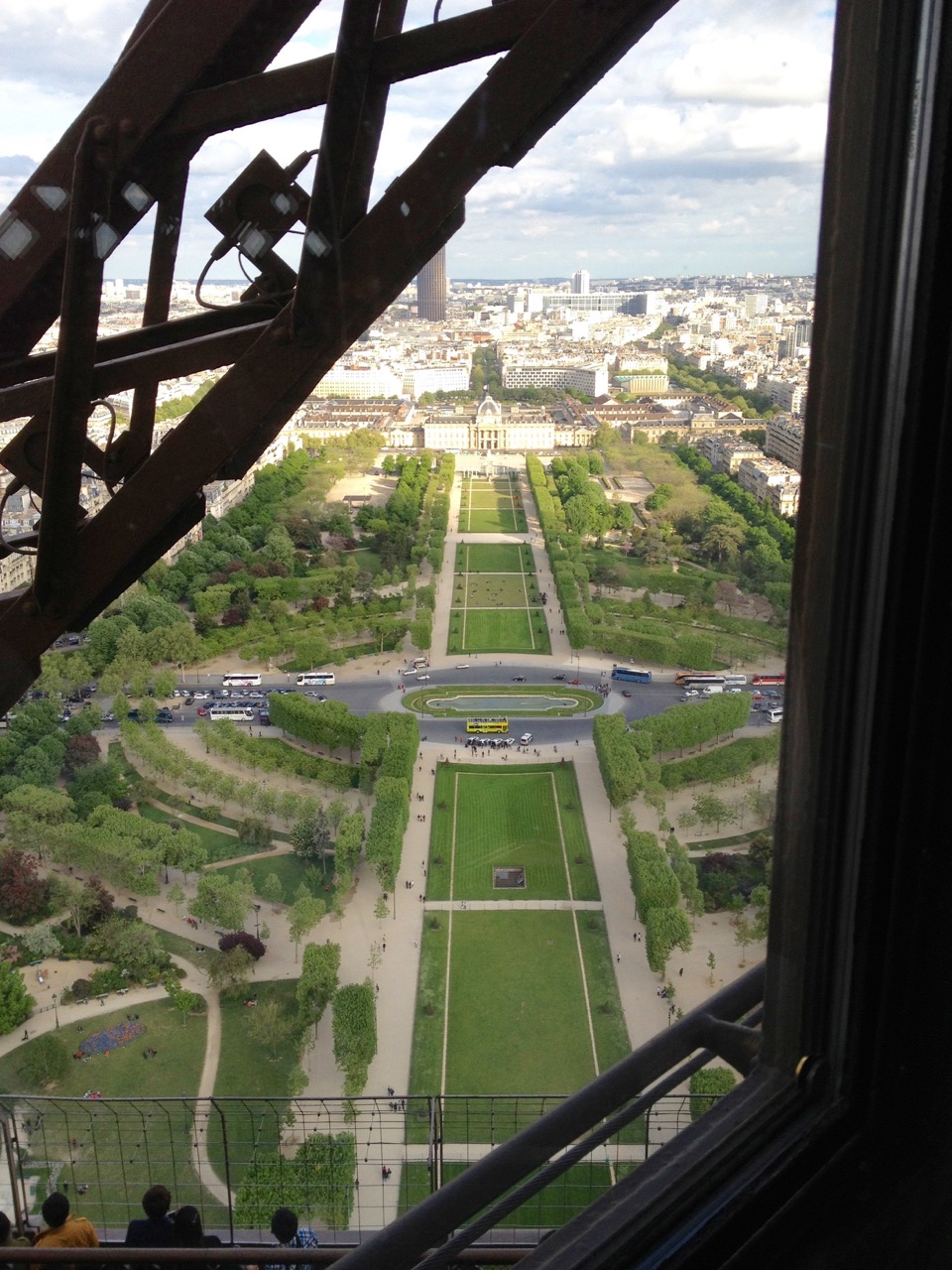 I don’t care for heights and never have, but in the past few years while traveling to many destinations overseas, I’ve done my best to overcome this fear by concentrating on anything, but the ground below. So as we ascended in the Eiffel Tower’s private elevator, I focused on photographing the tower itself, astounded by the engineering feat of building such a massive structure. After the short ascent to the second floor, which is one flight above the highest observation deck, the elevator landed and we were shown to a window seat in the restaurant. We had a breathtaking, panoramic view as the sun set over the City of Lights. I switched off my flash, so as not to disturb the other diners, and snapped at least a dozen photos of the city and several of the Parc du Champ-de-Mars that stretched out below.
I don’t care for heights and never have, but in the past few years while traveling to many destinations overseas, I’ve done my best to overcome this fear by concentrating on anything, but the ground below. So as we ascended in the Eiffel Tower’s private elevator, I focused on photographing the tower itself, astounded by the engineering feat of building such a massive structure. After the short ascent to the second floor, which is one flight above the highest observation deck, the elevator landed and we were shown to a window seat in the restaurant. We had a breathtaking, panoramic view as the sun set over the City of Lights. I switched off my flash, so as not to disturb the other diners, and snapped at least a dozen photos of the city and several of the Parc du Champ-de-Mars that stretched out below.
We ordered à la carte. For starters, we had lobster in a sabayon broth, and duck liver with fig jelly and brioche. Within the week, we would be eating plenty of fish, so that night we chose meat for dinner—pan-seared beef tournedos with soufflé potatoes and a Périgueux (rich brown) sauce, and saddle of lamb from the spit, artichokes, and a meat sauce. For dessert, a chocolate soufflé and savarin with an armagnac cream. Full, we walked off our meal along the banks of La Seine, then retired for the night. Next week, we board the TGV, France’s high-speed train, to Dijon, where we will rent a car and begin our tour of the Burgundy wine region.


